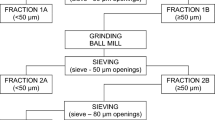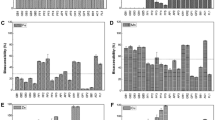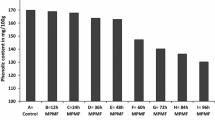Abstract
Rye was milled into flours having extraction rates between 100 and 65%. The nutritive value of the various fractions was studied by chemical analyses and in balance trials with rats. The concentration of essential nutrients decreased when the extraction rate was lowered. The lysine content (g/16 g N) was 4.23 in whole rye, but only 3.76 in the 65% extraction flour, and a corresponding reduction in biological value was found. A reduction of 50% or more was observed for several minerals with zinc and phosphorus being most affected. The apparent zinc absorption and retention expressed in absolute values, were significantly higher from the flours of high extraction than from the more refined flours, in spite of a much higher phytate content in whole rye and lightly milled flours. It could be concluded that milling of rye into highly refined flours not only preclude considerable amounts of nutrients from human consumption, but the remaining flours have a much poorer nutritive value than flour made from whole rye.
Similar content being viewed by others
References
Association of Official Agricultural Chemists (1979) Official methods of analysis, 10th ed. Washington DC: Association of Official Agricultural Chemists
Bagheri SM, Gueguen L (1981) Influence of wheat bran diets containing unequal amounts of calcium, magnesium, phosphorus and zinc upon the absorption of these minerals in rats. Nutr Rep Int 24:47–56
Davies NT, Flett AA (1978) The similarity between alkaline phosphatase (EC 3.1.3.1.) and phytase (EC 3.1.3.8) activities in rat intestine and their importance in phytate-induced zinc deficiency. Br J Nutr 39:307–316
Davies NT, Hristic V, Flett AA (1977) Phytate rather than fibre in bran as the major determinant of zinc availability to rats. Nutr Rep Int 15:207–214
Davies NT, Nightingale R (1975) The effects of phytate on intestinal absorption and secretion of zinc, and whole body retention of Zn, copper, iron and manganese in rats. Br J Nutr 34:243–258
Davies NT, Olpin SE (1979) Studies on the phytate:zinc molar contents in diets as a determinant of Zn availability to young rats. Br J Nutr 41:591–603
Eggum BO (1973) A study of certain factors influencing protein utilization in rats and pigs. Copenhagen: Beretn. 406 National Institute of Animal Science
Eggum BO (1977) Nutritional aspects of cereal proteins. In: Muhammed A, Aksel R, von Borstel RC (eds) Genetic diversity in plants. New York: Plenum, pp 349–369
Eggum BO, Christensen KD (1975) Influence of tannin on protein utilization in feedstuffs with special reference to barley. In: Breeding for seed protein improvement using nuclear techniques. Vienna: International Atomic Energy Agency, pp 135–143
Eggum BO, Thorbek G, Beames RM, Chwalibog A, Henckel A (1982) Influence of diet and microbial activity in the digestive tract on digestibility, and nitrogen and energy metabolism in rats and pigs. Br J Nutr 48:161–175
Erdman JW (1981) Bioavailability of trace minerals from cereals and legumes. Cereal Chem 58:21–26
Gill JL (1978) Design and analyses of experiments in the animal and medical sciences, vol 1. Iowa: The Iowa State University Press
Hjarde W, Sørensen A (1977) Klidtilførslens betydning for udnyttelsen af fødens mineralindhold. Husholdningsrådets Tekniske Meddelelser 17:26–32
Hoff-Jørgensen E, Porsdal V (1976) Fytaseaktiviteten i rugmel og fytinindholdet i rugbrød. Beretn. I fra Kornudvalget. København: Akademet for de tekniske Videnskaber, pp 40–58
Kelsay JL (1981) Effect of diet fibre level on bowel function and trace mineral balances of human subjects. Cereal Chem 58:2–5
Khan AM, Eggum BO (1979) The nutritional quality of some Pakistani wheat varieties. J Sci Food Agric 30:779–784
Koivistoinen P (ed) (1980) Mineral element composition of Finnish foods. Acta Agri Scand Suppl 22
Krziwanek S von, Kirchgessner M, Grassmann E (1978) Zum Einfluss einer Lysinergänzung zu Weizenkleber auf hämatologische Kriterien und Aktivitäten einiger Metalloenzyme. Z Tierphysiol Tierernährg u Futtermittelkde 40:310–315
Lo GS, Settle SL, Steinke FH, Hopkins DT (1981) Effect of phytate: zinc molar ratio and isolated soybean protein on zinc bioavailability. J Nutr 11:2223–2235
McCance RA, Widdowson EM, Moran T, Pringle WJS, Macrae TE (1945) The chemical composition of wheat and rye and of flours derived therefrom. Biochem J 39:213–222
MacRae JC, Armstrong DG (1968) Enzyme method for determinaton of α-linked glucose polymers in biological materials. J Sci Food Agric 19:578–581
Mason VC, Bech-Andersen S, Rudemo M (1980) Hydrolysate preparation for amino acid determinations in feed constituents. Z Tierphysiol Tierernährg u Futtermittelkde 43:146–164
Morris ER, Ellis R (1980) Bioavailability to rats of iron and zinc in wheat bran: Response to low-phytate bran and effect of the phytate/zinc molar ratio. J Nutr 110:2000–2010
Morris ER, Ellis R (1980) Effect of dietary phytate/zinc molar ratio on growth and bone zinc response of rats fed semipurified diets. J Nutr 110:1037–1045
Møllgaard H (1946) On phytic acid, its importance in metabolism and its enzymic cleavage in bread supplemented with calcium. Biochem J 40:589–603
Nahapetian A, Young VR (1980) Metabolism of14C-phytate in rats: Effect of low and high dietary calcium intakes. J Nutr 110:1458–1472
O'Dell BL (1969) Effect of dietary components upon zinc availability. A Review with original data. Am J Clin Nutr 22:1315–1322
Reinholdt JG, Faradji B, Abadi P, Ismail-Beigi F (1976) Binding of zinc to fibre and other solids of wholemeal bread. In: Prasad AS (ed) Trace elements in human health and disease, vol 1. New York: Academic Press, pp 163–180
Schroeder HA (1971) Losses of vitamins and trace minerals resulting from processing and preservation of foods. Am J Clin Nutr 24:562–573
Silano V (1977) Factors affecting digestibility and availability of proteins in cereals. In: Nutritional evaluation of cereal mutants. Vienna: International Atomic Energy Agency
Stoldt W (1952) Vorschlag zur Vereinheitlichung der Fettbestimmung in Lebensmitteln. Fette und Seifen 54:206–207
Stuffins CB (1967) The determination of phosphate and calcium in feeding stuffs. Analyst 92:107–113
Toepfer EW, Polansky MM, Eheart JF, Slover HT, Morris ER, Hepburn FN, Quackenbush FW (1972) Nutrient composition of selected wheats and wheat products. XI. Summary. Cereal Chem 49:173–186
Trowell HC (1978) Recent developments in dietary — fibre hypotheses. In: Heaton KW (ed) Third Kellogg Nutrition Symposium Dietary fibre: Current developments of importance to health. London: Newman Publishing
Turnlund JR (1982) Bioavailability of selected minerals in cereal products. Cereal Foods World 27:152–157
Wheeler EL, Ferrel RE (1971) A method for phytic acid determination in wheat and wheat fractions. Cereal Chem 48:312–320
Young VR, Janghorbani M (1981) Soy protein in human diets in relation to bioavailability of iron and zinc: A brief overview. Cereal Chem 58:12–18
Author information
Authors and Affiliations
Rights and permissions
About this article
Cite this article
Pedersen, B., Eggum, B.O. The influence of milling on the nutritive value of flour from cereal grains. 1. Rye. Plant Food Hum Nutr 32, 185–196 (1983). https://doi.org/10.1007/BF01091339
Received:
Revised:
Issue Date:
DOI: https://doi.org/10.1007/BF01091339




